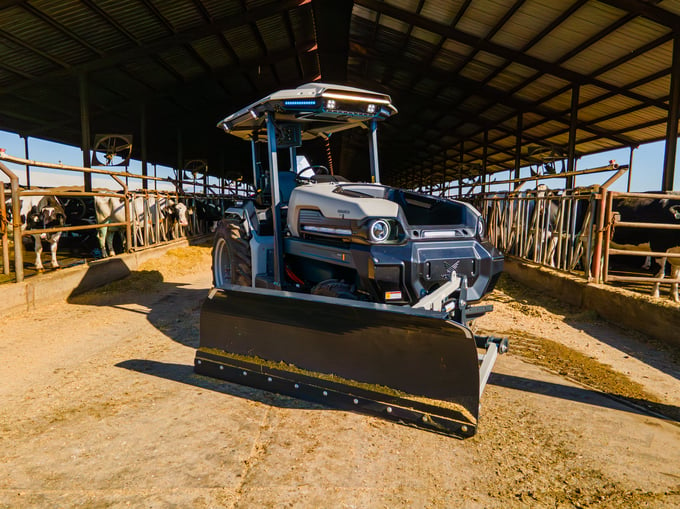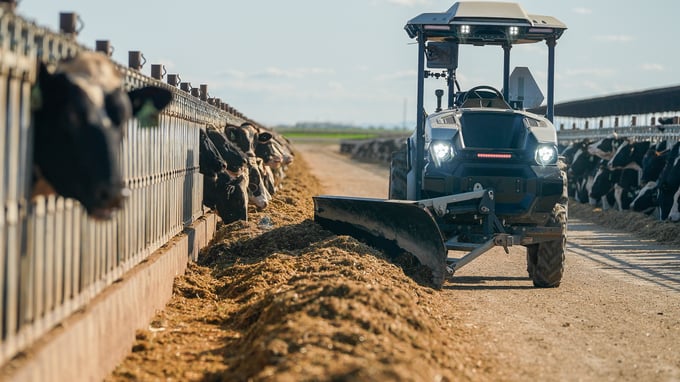Ice cream. Cheese. Yogurt. Butter. Is your mouth watering yet? These are some of the more delicious reasons to celebrate National Dairy Month, which has been recognized every June since 1937. With the introduction of its advanced MK-V dairy feed pusher, Monarch Tractor joins a long, proud history of agricultural innovation in the dairy industry that helps dairy farmers keep America supplied with its favorite treats and nutritious foods.
A Tradition of Innovation
Today’s dairy farms rely on farm robotics, but it hasn’t always been that way. During those early years when National Dairy Month began, dairy farm herds ranged from 5-20 cows, about the size a family could manage without advanced technological assistance. Dairy Herd Management reports that by 2020, individual herd size had grown to about 300 head per farm. Larger-scale farms easily have herds in the thousands. From 2003 to 2020 the number of U.S. dairy farms dropped by more than half. Dairy farm consolidation in the form of fewer farms and larger herds remains a trend, according to Dairy Herd Management.
Embracing innovative ag technology is the only way to manage so many cows. And dairy, more than any other farm sector, has a history of being early adopters of AgTech, especially in the form of farm robotics and automation. Robotic milking technology, or automatic milking systems, have been around for more than 30 years. There are also automatic cup removers, automatic milk plant wash systems, electronic cow identification systems, and herd management software. In an impressive push towards sustainability, dairy farms are even turning manure into electricity!
Monarch is adding to this list and giving dairy farmers a brighter future. With its 100% electric, driver-optional, smart tractor armed with an advanced dairy feed push blade, we’re empowering dairy farms to become more financially secure with happier and healthier cows.
Milking the Profitability
How can a feed blade give dairy farmers a taste of freedom both in terms of time and money? By itself, it can’t. But when coupled with the autonomy, data, and electrification that are wrapped into a MK-V, the savings stack up:
-
Increased Milk Production. Because the MK-V tractor can push feed autonomously, it allows farmers to push feed more frequently, as much as once each hour. Cows eat more feed, which results in more milk production and greater profits for the farmer.
-
Labor and Fuel Savings. Pushing feed is a 24/7 operation, and with the high costs of labor dairy farmers are forced to weigh the cost of wages against the gains of keeping cows well fed and producing ample amounts of milk. Pushing feed with an MK-V eliminates labor and fuel costs along with the extra bonus of having a tractor in a barn that quietly hums along with no smelly and toxic exhaust fumes.
-
Decreased Feed Refusal. By pushing feed more frequently, dairy farmers can improve feed refusal rates, potentially bringing it to at or below 4%.
We estimate that a 1,000 head farm can earn up to $95,000 per year by each cow eating one pound more feed per day (calculated with 2 lbs. milk increase at $.22 per pound). This is after factoring in electricity costs to power a MK-V plus savings in labor and diesel. For each 1% decrease in feed refusal, a 1,000 head dairy can realize an estimated $80,000 each year in savings.
Land of Milk & Honey & Ag Technology
Dairy farmers continue to demonstrate a willingness to integrate sustainable and new technological solutions. Monarch Tractor is proud to give them a valuable resource to help make their milk production high and their farms clean and sustainable; a huge benefit to the cows, the farmers, and surrounding communities . . . right down to the bees who help pollinate the corn for silage. So even though Dairy Month 2023 is coming to a close, Monarch is just getting started in supporting America’s dairy farmers!
References:
Feiereisel, Amy. (2017, July 14) Early Milk Transportation & Dairy Plants, from the 1800s to the 1930s. North County Public Radio. https://www.northcountrypublicradio.org/news/story/34034/20170714/early-milk-transportation-dairy-plants-from-the-1800s-to-the-1930s
Hanson, Maureen (2021, August 13) U.S. Dairy Herd Hits 27-Year High. Daily Herd Management. https://www.dairyherd.com/news/dairy-production/us-dairy-herd-hits-27-year-high
USDA: https://www.ers.usda.gov/webdocs/publications/45868/17034_err47b_1_.pdf
* Dairy feed push blade: pre-production feature and implement shown. Production feature and implement may vary.




